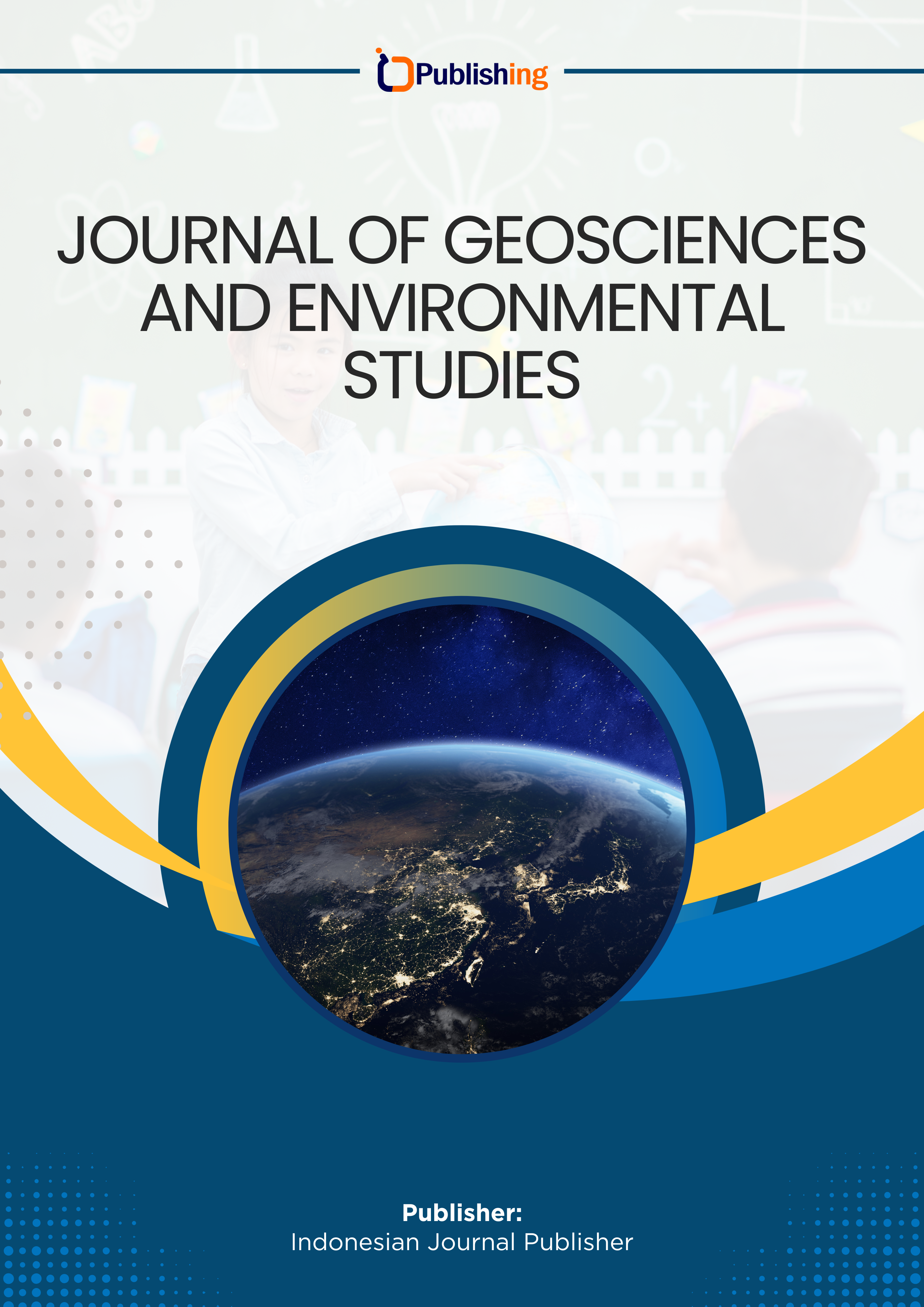Commodity Zoning and Identification of Agricultural Practices Using an Agroecological Approach in Selur Village
DOI:
https://doi.org/10.53697/ijgaes.v2i1.3597Keywords:
Agriculture, Agroecology, Agroecological ZonesAbstract
Selur Village is an agrarian village where most residents rely on the agricultural sector as their primary source of livelihood. However, this sector faces challenges such as limited irrigation access, suboptimal land management, and the impacts of climate change. Agroecology offers an integrative solution combining ecological, social, and cultural aspects to enhance agricultural sustainability. This study aims to delineate superior commodity zoning through agroecological maps tailored to the biophysical potential of the area and to understand local farming practices based on agroecological principles. The research employs a mixed-method approach, with primary data obtained through interviews with 18 farmers, analyzed using Deductive Qualitative Analysis (DQA) to describe current farming practices, which were then interpreted about agroecological principles. Secondary data, including slope, elevation, air temperature, rainfall, and soil type, were spatially analyzed using QGIS to produce agroecological zone maps. Land suitability assessment was conducted using the matching method, aligning land characteristics with crop growth requirements. The results indicate that the majority of land in Selur village is suitable for perennial crops and forestry. Key commodities such as rice, maize, turmeric, and horticultural crops exhibit high compatibility with land conditions. The findings emphasize the application of agroecological principles, including crop diversification, soil conservation, and resource recycling, but highlight the need for further interventions. The study concludes by recommending strategies such as sustainable intensification, land rehabilitation, and enhanced market access to optimize agricultural productivity and resilience in Selur Village.
References
Aristin, N. F., Purnomo, A., & Sejati, S. P. (2023). Sustainability of Dryland, Farmers, and Local Industry: Dryland of Cassava Model. Journal of Sustainability Science and Management, 18(7), 104–125. https://doi.org/10.46754/jssm.2023.07.007 DOI: https://doi.org/10.46754/jssm.2023.07.007
Berkes, F., Colding, J., & Folke, C. (2000). Rediscovery of Traditional Ecological Knowledge as Adaptive Management. Ecological Applications, 10(5), 1251–1262. https://doi.org/10.2307/2641280 DOI: https://doi.org/10.1890/1051-0761(2000)010[1251:ROTEKA]2.0.CO;2
BPS. (2018). Statistik Potensi Desa Indonesia Tahun 2018.
Corral, S., Díaz, A. S., Monagas, M. del C., & García, E. C. (2017). Agricultural policies and their impact on poverty reduction in developing countries: Lessons learned from three water basins in Cape Verde. Sustainability (Switzerland), 9(10). https://doi.org/10.3390/su9101841 DOI: https://doi.org/10.3390/su9101841
Djaenudin, D., H., M., H., S., & Hidayat, A. (2011). Petunjuk Teknis Evaluasi Lahan untuk Komoditas Pertanian. In Petunjuk Teknis Evaluasi Lahan untuk Komoditas Pertanian. (2nd ed.). Bogor: Balai Besar Penelitian dan Pengembangan Sumberdaya Lahan Pertanian.
Fife, S. T., & Gossner, J. D. (2024). Deductive Qualitative Analysis: Evaluating, Expanding, and Refining Theory. International Journal of Qualitative Methods, 23, 1–12. https://doi.org/10.1177/16094069241244856 DOI: https://doi.org/10.1177/16094069241244856
Giller, K. E., Delaune, T., Silva, J. V., Descheemaeker, K., van de Ven, G., Schut, A. G. T., van Wijk, M., Hammond, J., Hochman, Z., Taulya, G., Chikowo, R., Narayanan, S., Kishore, A., Bresciani, F., Teixeira, H. M., Andersson, J. A., & van Ittersum, M. K. (2021). The future of farming: Who will produce our food? Food Security, 13(5), 1073–1099. https://doi.org/10.1007/s12571-021-01184-6 DOI: https://doi.org/10.1007/s12571-021-01184-6
Hidayati, I. N., & Suryanto, S. (2015). Pengaruh Perubahan Iklim Terhadap Produksi Pertanian Dan Strategi Adaptasi Pada Lahan Rawan Kekeringan. Jurnal Ekonomi & Studi Pembangunan., 16(1), 42–52. https://doi.org/10.18196/jesp.16.1.1217
Kesuma, C. P. (2024). Tinjauan Pemanfaatan Hutan Pinus di Kabupaten Gayo Lues Berdasarkan UU No.41 Tahun 1999 Tentang Kehutanan. Aliansi: Jurnal Hukum, Pendidikan Dan Sosial Humaniora, 1(4), 215–235. https://doi.org/10.62383/aliansi.v1i4.319 DOI: https://doi.org/10.62383/aliansi.v1i4.319
Pandangwati, S. T., Cooke, B., & Neave, M. (2024). Farmers, planning and Agroecological transition: insights from the special region of Yogyakarta, Indonesia. Australian Geographer, 55(2), 229–257. https://doi.org/10.1080/00049182.2024.2350813 DOI: https://doi.org/10.1080/00049182.2024.2350813
Pemerintah Desa Selur. (2024a). Status IDM Desa Selur. 1–5.
Pemerintah Desa Selur. (2024b). Data Penduduk Desa Selur. Retrieved from https://selur.desa.id/first/statistik/13
Pretty, J. (2003). Social Capital and the Collective Management of Resources. Science, 302(5652), 1912–1914. https://doi.org/10.1126/science.1090847 DOI: https://doi.org/10.1126/science.1090847
Pusat Penelitian Tanah dan Agroklimat. (1999). Panduan Metodologi Analisis Zone Agro Ekologi (I).
Siagian, D. R. (2021). Peta Pewilayahan Komoditas Pangan Berdasarkan Zona Agroekologi (ZAE) Skala 1:50000 di Sumatera Utara. Bogor: Balai Besar Pengkajian dan Pengembangan Teknologi Pertanian (BBP2TP).
Sihombing, Y. (2021). Peran Sektor Pertanian terhadap Perekonomian Wilayah Perdesaan dalam Mengentaskan Kemiskinan. Agrista: Jurnal Ilmiah Mahasiswa Agribisnis UNS, 5(1), 936–945.
Simon-Rojo, M. (2023). The role of ecosystem services in the design of agroecological transitions in Spain. Ecosystem Services, 61(March), 101531. https://doi.org/10.1016/j.ecoser.2023.101531 DOI: https://doi.org/10.1016/j.ecoser.2023.101531
Sinclair, F., Wezel, A., Mbow, C., Chomba, S., Robiglio, V., & Harrison, R. (2019). The Contribution of Agroecological Approaches To Realizing Climate-Resilient Agriculture. Global Commission on Adaptation to Inform Its 2019 Flagship Report, 46. Retrieved from www.gca.org
Susanto, B., & Hamdani, K. K. (2021). Pewilayahan Komoditas Pertanian Berdasarkan Zona Agroekologi di Kabupaten Cirebon Bagian Timur. 37(3), 2–7. https://doi.org/10.25181/jplantasimbiosa.v3i1.1957 DOI: https://doi.org/10.25181/jplantasimbiosa.v3i1.1957
Wati, R. S., & Munir, I. M. (2016). Potensi Lahan Basah untuk Pengembangan Padi Sawah Berdasarkan Zona Agroekologi di Kabupaten Serang, Provinsi Banten. 1–10. https://doi.org/10.13140/RG.2.2.25591.83364
Downloads
Published
How to Cite
Issue
Section
License
Copyright (c) 2025 Krisma Hutanti

This work is licensed under a Creative Commons Attribution-ShareAlike 4.0 International License.














